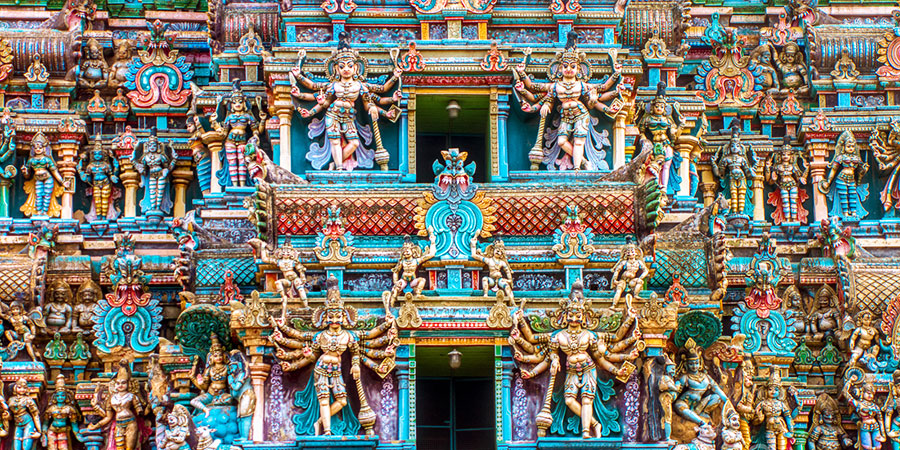Meenakshi Temple - The Ancient Temple of Madurai
Madurai, one of the important temple towns of Tamil Nadu, is widely popular among Hindus. The city has even found its mention in different historical documents belonging to the ancient Roman Era. Once the busy trade center of ancient India, Madurai still attracts the attention of numerous visitors who come to the city to soak in the beauty of this stunning town.Madurai has close to ten major and over twenty smaller temples, making it an important center for pilgrimage among Hindus. Among these temples, the Meenakshi Amman Temple, or simply the Meenakshi Temple in Madurai is one of the most important landmarks of this town. Each day several devotees come here to pay their respects to the goddess Meenakshi and her divine consort Sundareshwarar.
This Madurai Meenakshi Temple guide can come handy for visors planning a trip to this place.
Highlights of Meenakshi Temple in Madurai
![]() Address: Madurai Main, Madurai, Tamil Nadu 625001
Address: Madurai Main, Madurai, Tamil Nadu 625001
![]() Opening time: 9:00 am to 7:00 pm
Opening time: 9:00 am to 7:00 pm
![]() Time required: Usually 1 hour
Time required: Usually 1 hour
![]() Best known for: Stunning temple architecture in Dravidian style
Best known for: Stunning temple architecture in Dravidian style
![]() Entry fee: Free
Entry fee: Free
![]() Special attractions: Temple architecture
Special attractions: Temple architecture
![]() Important festivals: Meenakshi Thirukalyanam
Important festivals: Meenakshi Thirukalyanam

Meenakshi Temple
|
Meenakshi Amman Temple (A Brief Glimpse)
The Meenakshi temple, Madurai is considered as the abode of warrior goddess of the same name. The name Meenakshi is derived from two Sanskrit words ‘meen’ meaning fish and ‘aakshi’ meaning eyes. Thus the name signifies the person who has beautiful eyes, similar to a fish – an epithet for near-perfect eyes in the Tamil classics.One of the important temples of Tamil Nadu comprises of fourteen giant gopurams (tall towers) and spread in the area of the 6-hectare complex, the Madurai Meenakshi temple is simply spellbinding. The stucco figurines on the gopurams (comprising of heroes, goddesses, gods, and demons) watch over devotees who come here.
As per several legends, the beautiful fish-eyed goddess was born as a boon to the childless king. The girl had beautiful eyes, big and peering, and named as Meenakshi. The princess was proficient in the arts of warfare, excelling even the most experienced warriors. The king began searching for a suitable match of the princess who would be worthy enough to rule the kingdom after the king’s demise.
However, no such suitor was found. After the king’s death, Meenakshi became the supreme of the nations and launched the campaigns against the enemies. During one such campaign, she was defeated by Sundareswara (believed to be the incarnation of Shiva). The princess agreed to marry the Sundareswara and came back to Madurai to rule her empire.
History
According to historical records, the King Kulasekara Pandya commissioned temple construction during his reign. The main portions of the temple, including three-tier tall gopura and portions of the main shrine, are accredited to the king. With the subsequent change in power, the temple complex was further expanded and several new features were added to the existing model.One can find the mention of the temple in several historical records dating back to the 7th century. The rulers like Vishwanatha Nayaka or Tirumalai Nayaka (both 14th-century rulers of Madurai) further expanded the Meenakshi Temple in Madurai introducing several architectural features like elaborate Vasantha Mandapam.
Numerous foreign invaders had ransacked the temple several times. However, each time the temple complex was rebuilt and redecorated. Unfortunately, only a few of the portions of the earliest architecture of the temple are still standing.
Architecture

|
The main deity of the temple is Meenakshi, who is worshipped here with her divine consort Sundareswarar. The main temple is enclosed by three complexes and houses the idols of the main deities. Meenakshi is carved out of black stone and is adorned with precious gems. The main temple structure is decorated with gilded towers that enhance the beauty of the entire structure.
Temple Significance
The temple has been associated with several important incidents in Hindu mythology, making the Meenakshi Temple, Madurai an important center for pilgrimage. According to several religious texts, the place is one of the locations where Shiva conducted his Tandav, and hence the presence of Nataraja statue at the Sundareswarar temple complex. However, the statue is a divergence from the archetypal Nataraja image. Here Lord Shiva is depicted dancing with his right leg raised, instead of his left leg.The important religious festival, Meenakshi Thirukalyanam or the marriage of the goddess is celebrated with great pomp and show. Here the woman, or the bride, is given preference instead of the groom – a digression from the traditional patriarchal society. The festivities last close to a month, where devotees celebrate the divine union. Other important festivals include Shivratri and Navratri.
The Meenakshi Temple, Madurai is a fine example of temple architecture. The place is simply stunning and showcases the diverse history of India.

